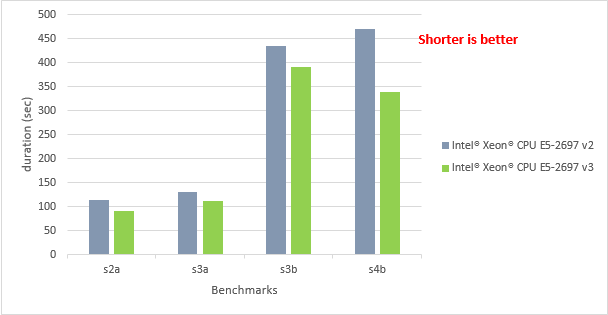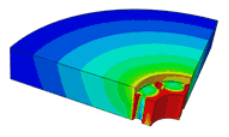Intel recently published a case study that demonstrates the advantages of the Intel Xeon E5-2600 v3 product family for running engineering workloads, using Dassault Systèmes’ SIMULIA-branded Abaqus/Standard software. Abaqus/Standard is general purpose finite element analysis (FEA) software, which works by sectioning an object into a large number of finite elements, each represented by an equation. As the individual equations are solved and integrated, the whole object is mathematical modeled.
The writeup by Intel Software Engineer Khang observes that Abaqus/Standard includes many analysis capabilities, and is, according to the product literature “ideal for static and low-speed dynamic events where highly accurate stress solutions are critically important.” Examples cited by the software vendor include sealing pressure in a gasket joint, steady-state rolling of a tire, or crack propagation in a composite airplane fuselage.
“Within a single simulation, it is possible to analyze a model both in the time and frequency domain,” continues the summary from the Abaqus/Standard product page. “For example, one may start by performing a nonlinear engine cover mounting analysis including sophisticated gasket mechanics. Following the mounting analysis, the pre-stressed natural frequencies of the cover can be extracted, or the frequency domain mechanical and acoustic response of the pre-stressed cover to engine induced vibrations can be examined.”
For the time integration component, Abaqus/Standard solvers employ a function called DGEMM (Double-Precision General Matrix Multiplication), which is found in the Intel Math Kernel Libraries (Intel MKL). In Intel MKL version 11 update 5, and later versions, DGEMM was optimized to use the new Intel AVX2 extensions introduced in Intel’s Haswell microarchitecture. This optimization provides many workloads with a performance boost beyond that owed to improved hardware alone.
“Analysis of Abaqus workloads using performance monitoring tools, such as Intel VTune, showed a significant number of them spend 40% to 50% of their runtime time in DGEMM. Further analysis of the DGEMM function showed that it makes extensively used of the multiply-add operation since DGEMM is, basically, matrix multiplication,” explains Khang.
“One of the new instructions in Intel AVX2 is the three-operand fused multiply-add (FMA3). By implementing the combined multiply-addition operation in the hardware, the speed of this operation is considerably improved.”
The case study documents the performance gain that is obtained with this newer DGEMM implementation that takes advantage of Intel AVX2. Two platforms were used, one with Intel Xeon E5-2697 v3 @2.6GHz and the other with Intel Xeon E5-2697 v2 @2.7GHz. The operating system is Red Hat Enterprise Linux Server release 6.4 and the application is Abaqus/Standard benchmarks version 6.13-1. Tests were measured in seconds.
Four benchmarks from Abaqus/Standard were used: s2a, s3a, s3b and s4b.
- S2a is a nonlinear static analysis of a flywheel with centrifugal loading.
- S3 extracts the natural frequencies and mode shapes of a turbine impeller.
- S3a is a 360,000 degrees of freedom (DOF) using Lanczos Eigensolver version.
- S3b is a 1,100,000 degrees of freedom (DOF) using Lanczos Eigensolver version.
- S4 is a benchmark that simulates the bolting of a cylinder head onto an engine block.
- S4b is a 5,000,000 degrees of freedom (DOF) using direct solver version.
The researchers ran the four benchmarks on the Xeon E5-2697 v2 system, on the E5-2697 v3 system with AVX2 enabled, and again on the E5-2697 v3 system but with AVX2 disabled.
Here are the results:

Comparison between Intel Xeon E5-2697 v3 and E5-2697 v2 – the performance improvement due to enhanced hardware and Intel AVX2 ranges from 1.11X to 1.39X.

Comparison between benchmarks on Xeon E5-2697 v3 with Intel AVX2 enabled and disabled – the performance increase due to Intel AVX2 alone ranges from 1.03X to 1.11X.
Although benefits of this degree were anticipated, it is affirming to have the hard numbers provided by the study. It would have been interesting to see a third chart with the relative performance of all three configurations (essentially a superposition of the two charts above) to illustrate what percentage of the total performance increase (as depicted in the first chart) is owed to AVX2.
The takeaway for users of this software who have moved over to the Xeon E5 v3 “Haswell” product family, is to make sure they are using the latest libraries.
“Simulation software performance is very critical since it can significantly reduce the model development and analysis time,” concludes the author. “Abaqus/Standard is well-known for FEA that relies on DGEMM for its solvers. As a result of the introduction of Intel AVX2 in the Intel Xeon E5-2600 v3 Product Family, and as a result of the Intel MKL augmentation to take advantage of Intel AVX2, a simple change to the Abaqus/Standard to use the latest libraries yielded a considerable performance improvement.”





























































